My blog posts are a little out of order as I’ve yet to write up our Australian adventures, but whilst they’re still fresh in my mind, I thought I’d narrate our stories so far from the beguiling country of Indonesia.
Travelling through Indonesia is slow, somewhat difficult and fairly unpredictable. The only thing you can be sure of is that something will go wrong with your plans somewhere! For example, we have eight flights planned to move us around this country and all bar one has been changed! Mostly this was simply because Garuda, the national airline, randomly decided to cancel the majority of our flights at the last minute, with no compensation for the impact this had on the rest of our plans… It would be like BA just cancelling the odd flight with no explanation and leaving you to sort out the implications! But that’s how it goes with Indo. Once you accept that, it becomes much easier. A go-with-the-flow, flexible attitude is essential. As is time. You simply can’t move anywhere quickly.
But it’s so incredibly worth it on many different levels, from the welcoming people to the pristine coral reefs to the unique experiences, such as visiting a local Bajo village, a tribe of sea gypsies. Here’s an overview of the journey to date.
The Journey
The first part of our time in Indo was focussed on getting us to the tiny and isolated tropical island of Hoga in the Wakatobi region, off the south east coast of Sulawesi. My dad runs an ecotourism project called Operation Wallacea (Opwall), a conservation research organisation funded by teams of student volunteers who join expeditions for the opportunity to work on real-world research programmes alongside academic researchers. There are 15 main sites scattered across the world, but the very first to be set up was on Hoga Island, which we discovered whilst travelling through Indonesia as a family 25 years ago. I’ve spent many months on Hoga and even did my university project out there (on the foraging habits of anemonefish!), but I’d not been back for at least 20 years, so it was rather an emotional journey for me.
The data collected by OpWall was used to establish the Wakatobi Marine National Park, which at 13,900 square km, is four times the size of Kent! In 2015, the data was used to upgrade the Wakatobi Park to World Heritage Status. This combined with its isolation makes it one of the most pristine and biodiverse sites in the world. Understandably, I was very keen for the Beans to have the opportunity to visit this special place. After discussing with my dad, we decided to liaise our trip with the University of Essex’s undergraduate and post graduate marine biology field trip to the island. This meant there were dive instructors onsite and marine biology lectures to gatecrash!
To Hoga…
Getting to Hoga is no mean feat. We landed late in the evening from Sydney into Denpasar, Bali. So late in fact that the Beans fell fast asleep on the hard plastic chairs in the arrivals lounge whilst we waited for the bags, which took forever – Indonesian inefficiencies significantly increased their nap time! This did mean though that their slightly discombobulated post-sleep state made the carnage of our exit out of the airport even more tricky, as I tried to corral wandering children through the crowds of Indonesians desperately trying to get our attention to use their taxi services. Head down, we persevered to the “official” taxi rank and arranged our transportation.

Unfortunately though, whilst very gentle, the taxi man we selected seemed completely incapable of following a map. He had Google Maps set up to help him navigate through the tiny mud streets, but literally at every turning, he went in the opposite direction to the one shown on the map! At one point, we ended up down a dead end behind some ramshackle houses and surrounded by stray dogs. At this point, MrJ could withhold his frustration no longer and took control of the directions, finally locating the “villa” we’d booked, in the middle of nowhere. With hindsight, it would have been easier to book into a hotel for the night, but this was certainly more memorable. It was somewhat rough around the edges, but the beds were clean and closing up the mosquito nets, we fell into bed, all crashing out immediately.
The morning heralded a beautiful day, so we headed out to wander around the back streets to explore in the hot, sticky environment. The Beans were interested by the Hindu offerings outside each house and although many of the houses were comfortable and the streets clean, these were intermixed with roads filled with rubbish and tumbledown shacks, but always with happy, smiling children playing in the streets. They watched in fascination as parents (with helmets) shuttled their babies and children (without helmets) around on mopeds, with just one arm slung around the baby/child to keep them safe…


We only had a short time before our next flight, so we took a trip to the local beach for a delicious Balinese lunch, followed by a swim in the sea to cool down and then on for (bizarrely) some of the most refreshing gelato I’ve ever tasted! Then, it was time to head back to the airport to meet with my dad, step mum and her sister and catch a plane to Makassar, one of the main cities in Sulawesi. Thanks to all the flight changes, we needed to spend a day and a couple of nights here before our next flight.

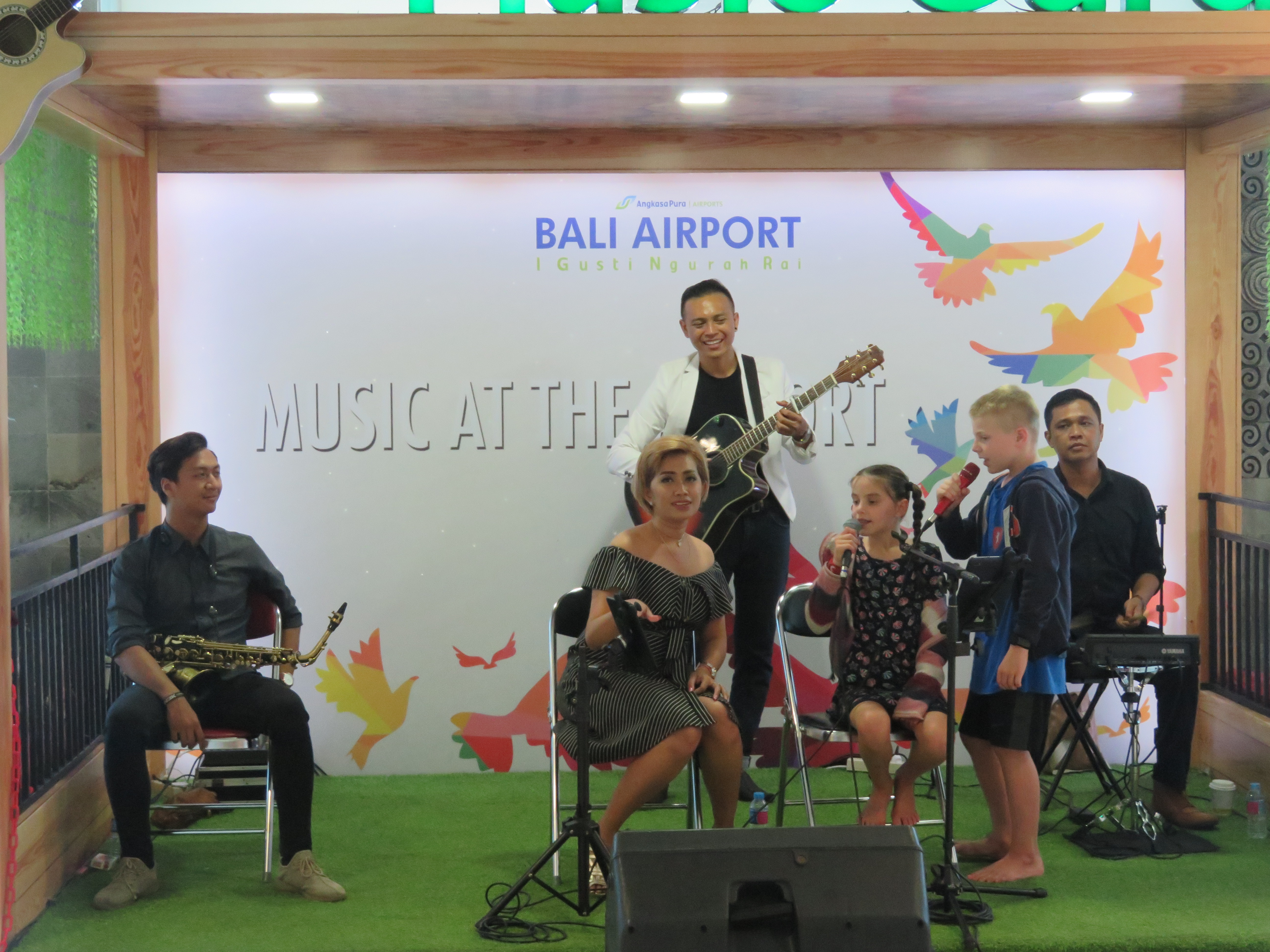
There’s not a great deal to do in Makassar but the Beans were fairly exhausted, so we took the opportunity for a slow day. We started with a visit to the local cathedral, intending just to have a look and fully expecting any Mass to be in Indonesia. But, by a stroke of luck, we happened upon an English spoken Mass and thus stayed and enjoyed it alongside a packed congregation of Indonesians. Following this, we revived ourselves with a nasi goreng (fried rice) and a post prandial slow walk along the waterfront past the floating mosque and back to our hotel. Although the heat and humidity were incredibly intense making any movement quite uncomfortable, I always find taking a walk the best way to get a feel for the place you’re staying. We happened upon some sort of practice for a mini festival on the waterfront, with dance routines (including a lot flag waving), a marching band and the obligatory groups of laughing children. Bean8 even got a chance to have a go at cycling a rickshaw!





A quick side note about the people:
The Indonesian people are some of the friendliest and most welcoming I’ve ever encountered. To be honest, after our experience of the kindness of Hong Kongers, New Zealanders, Aussies and Indonesians throughout our trip, I’ve decided to make a concerted effort to be extra welcoming and helpful to tourists once I’m back in the UK. It can make such a difference. But Indonesians especially have welcomed us with open arms.
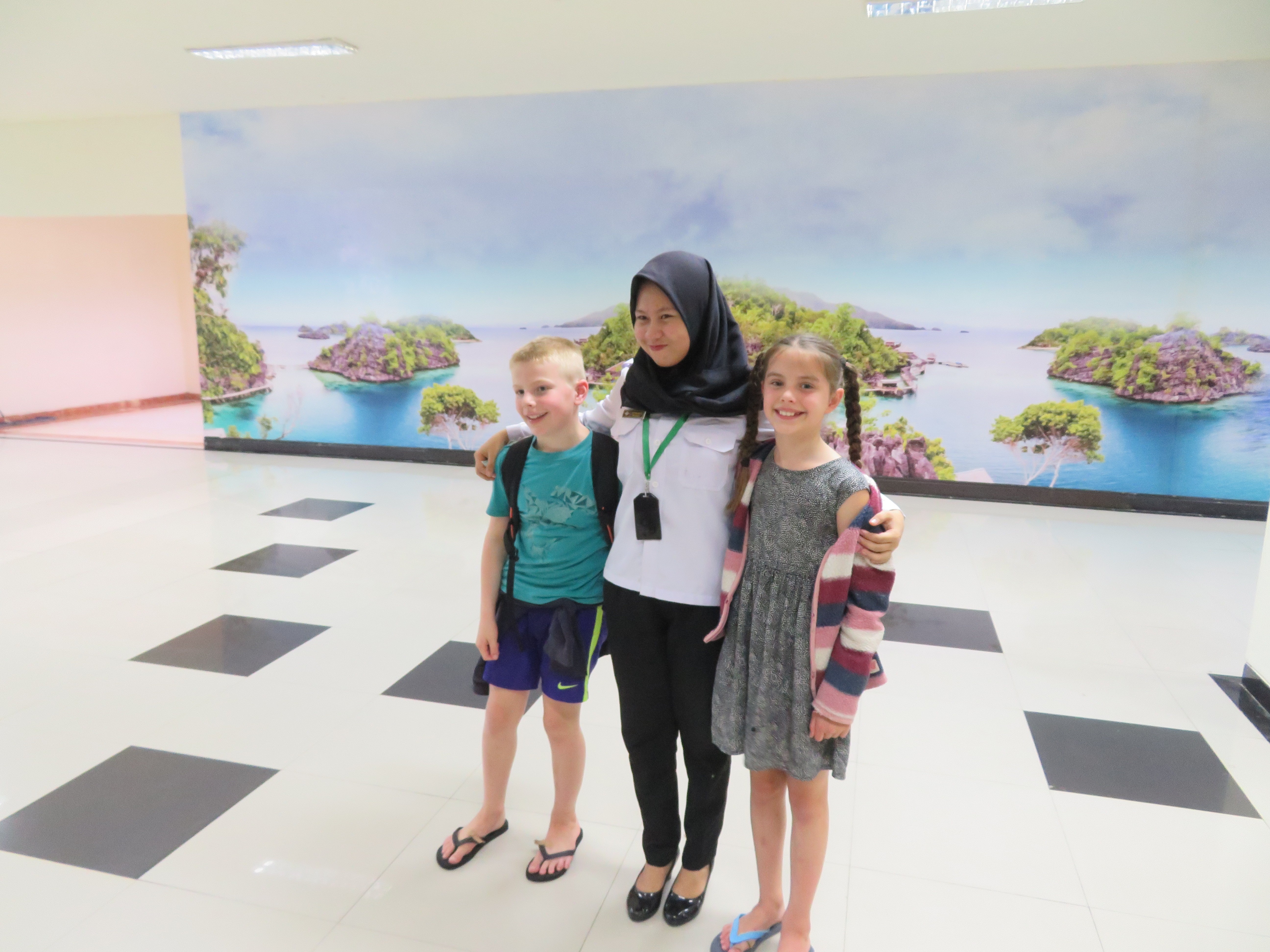
As we’re travelling off the beaten track in Indo, our white skin has given us somewhat of a celebrity status. The Beans (and especially Bean9) have been asked for their photos with at least fifty different Indonesians. Just this morning in the toilet during her breakfast buffet, two ladies asked if they could have their photo taken with Bean9. At first, she found this a little overwhelming, but she’s adapted. You can see her spotting the approaching lady with a shy smile and phone in hand, and almost like a pro, turning on the obligatory smile and pose for the camera!

She in particular, seems to have grown up substantially since arriving in this country. She was never shy, but her confidence has blossomed in a good way. She seems to stand taller somehow. I remember Indonesia having exactly the same effect on me when I travelled here as a teenager. I was painfully shy on arrival, but all the love and attention poured out from these beautiful people, allowed me to come out to come out from hiding in my shell and lose the awkward hunched shoulder posture that had become my standard.
But back to the journey:
The next day was a full-on day of travel involving two flights, many car transfers and two boats to get us onto Hoga. We set off very early in the morning for the first flight to Kendari where we liaised with the Essex group, followed by a lengthy wait in the airport and on to the next plane, a tiny twin propeller plane, which felt somewhat terrifying (especially given the safety record of the airline). I’ve never felt the need to pray for safety on a flight before, but I did on this one! Mercifully, we arrived safely into the tiny airport on Wanci and set off in a convoy of trucks along with the group of students, lecturers and the doctor to catch the boat.



As we set off, I had a sense that the back-left wheel must have been very low on air and a bad feeling that this truck wouldn’t get us to the port, which to be honest is very unusual for me as anything to do with the workings of a car is really not my forte. But half way into our drive, we limped to a halt at the side of a banana plantation, as it was now clear the wheel had a serious puncture and we were running on the inner rim. The car did have a spare wheel but whatever tool was required to release said spare was clearly missing… Obviously! This is Indonesia – as I said, always expect the unexpected when travelling in this country. Things will never go to plan! As a side note here, the same goes for ordering food in Indonesian restaurants (outside the main tourist areas). You’ll be presented with a menu and once you’ve chosen, they’ll diligently take your order, disappear off for a while and inevitably come back and tell you that actually they don’t have half of the items you’ve ordered. Asking them what is available is not really an option as they’re often not sure, so you repeat the ordering process several more times until you find something they can make that you fancy eating (although by this point, you’d probably be happy to eat anything they offered you!). Finding a restaurant well before you’re actually hungry is therefore essential!

But back to the banana plantation! Luckily, there was one more car behind us in the convoy and, nervous of missing the boat, we asked them to come back and pick us up once they’d dropped off their students (and to hurry as we were being eaten alive by the mosquitos and our bags with the mosquito repellent were on a different truck!). Finally, we made our way into the tiny port and quickly boarded the rickety boat. We still had a long way to go and it was getting late.


The first part of the boat journey was beautiful as it set out over crystal clear blue waters with the backdrop of the gorgeous flaming sunset. The Beans sat on the top of the boat with huge grins on their faces. Unfortunately though, this was the calm before the storm. Once we left the shelter of the islands, the sea became choppier and we had to come down from the top to the lower-sitting bow, but still outside rather than in the dark, hot and very smelly bowels of the boat. Initially, this proved to be a good spot. But as they sun set, I held on increasingly tightly to the Beans as we crashed through the waves watching the phosphorescence in the spray alongside (and over) us, chatting away to the doctor travelling with us and desperately trying to distract myself from just how dangerous it was as the waves became ever more ferocious – if they fell over the side (and there were no actual sides to the boat) in the pitch black of the huge ocean, we’d struggle to find them again. But by this stage, it was more perilous to move to a different position than to stay put.

Fortunately, when the waves became ridiculously high, they stopped the engine to allow us all to reposition inside and into the sweat pit filled with diesel fumes. It was safe but a hugely unpleasant environment. Even with my head stuck out the window, with no horizon to see in the dark, we all felt very sea sick. As we approached Hoga, in what appeared to be a complete surprise to the boatmen, they realised it was low tide (clearly tide timetables are not a thing in Indo!), so they rang through to the island for them to send a fleet of smaller boats to pick us up from the boat. Carefully and slowly, we transferred and finally the pier came into view. One by one, we climbed the slippery steps and onto dry land. A short walk along the pier, down the beach and into the forested inland saw us arrive in a slight daze at the meeting/eating hut for our evening meal. It was 8pm and we’d started our journey at 6:30am that morning. A long but memorable day’s travelling. And the best places in the world are often the hardest to reach. This Island of Hoga is most certainly worth the effort.
Hoga Island
Over dinner and unsurprisingly flagging by this point, we attempted to eat a little something to take with our malaria tablets, whilst the staff regaled us with a wonderful story of an enormous 6m-long python that had been spotted nearby in the last few days. Just what I needed to hear! They advised us not to let the Beans wander around on their own either at night or in the day, but not to worry as there had only been two sightings in the last 10 years. Had I been informed of this story in the morning after a good night’s rest, I would probably have received it in a much more pragmatic way, ensured the Beans were never alone, but would not have been overly concerned. As it was, I was tired and it’s never easy arriving somewhere new in the dark, particularly one so remote, so I was pretty terrified! As we arrived at our stilted accommodation for the evening – an isolated large wooden house with walls and a roof but a large gap between the two (definitely space for a python to slide through!) – my mind was alive with the possible dangers! That night, we each had one Bean in a double bed, with the knives we’d made in Barrytown safely stored under our pillows!
Day One
On waking to the beautiful sunny morning that greeted us, with the sun sparkling across the turquoise sea in the charming little bay near our hut, all my fears dissolved into nothing. I’m pleased to say pythons didn’t cross my mind for the rest of our stay!


Our first task: washing away all the grime from the previous day’s travel. It was the children’s first experience with a mandi – which is basically a large bucket of ice-cold water in the corner of a room with a tiled floor. You fill a smaller scoop-like bucket with the water and throw it over your head. They’d read about them in the All About Indonesia book we’d used to prepare ourselves for the trip and I’d told them how refreshing they are, but there’s nothing like a first-hand experience. I can’t deny the first scoop is somewhat of a shock to the system, but it feels oh so good to cool down. The heat and humidity on the island are more intense than anything we’ve ever experienced. It takes some getting used to.

Once cleaned and refreshed, we made our way down to the main hut for breakfast, a 7 minute walk along little paths weaving around the enormous jagged coral holes (that would cause some serious damage if you accidentally fell into one) and past local huts which have sprung up since the arrival of OpWall to the island. Friendly shouts of “Pagi” (morning) filled our ears as the kindly locals welcomed us. On our journey, we happened upon a large 1m-long monitor lizard lazily wandering down the path. These are fairly abundant on the island – we saw at least two each time we walked to or from our hut – and wonderful to watch. The wildlife on Hoga is exceptional. At night, we stood fascinated as huge coconut crabs scuttled across the beach ahead of us, whilst fireflies danced all around and large geckos (about 30cm long) flitted in and out of the eaves. By day, whilst laid in the hammock, we watched as the beautiful tiny sunbirds drank nectar from the scarlet flowers hanging nearby and butterflies of all different colours whirled around our heads.



After a breakfast of fried rice and porridge, we checked out the stunning beach before making our way to the dive centre ready for their PADI Bubblemaker course. This option is open for children 8 years old and up to have a go at SCUBA diving with an instructor, only to depths of around 2/3m. This gives them a feel for the sport whilst minimising any dangerous aspects (you can easily free dive to these depths with no issues). Our instructor was Alan, a lovely straight-talking man from Northumberland who I warmed to immediately. He was extremely experienced, very clear and patiently answered the multitude of questions fired at him from Bean8 who wanted to know how everything worked in detail!

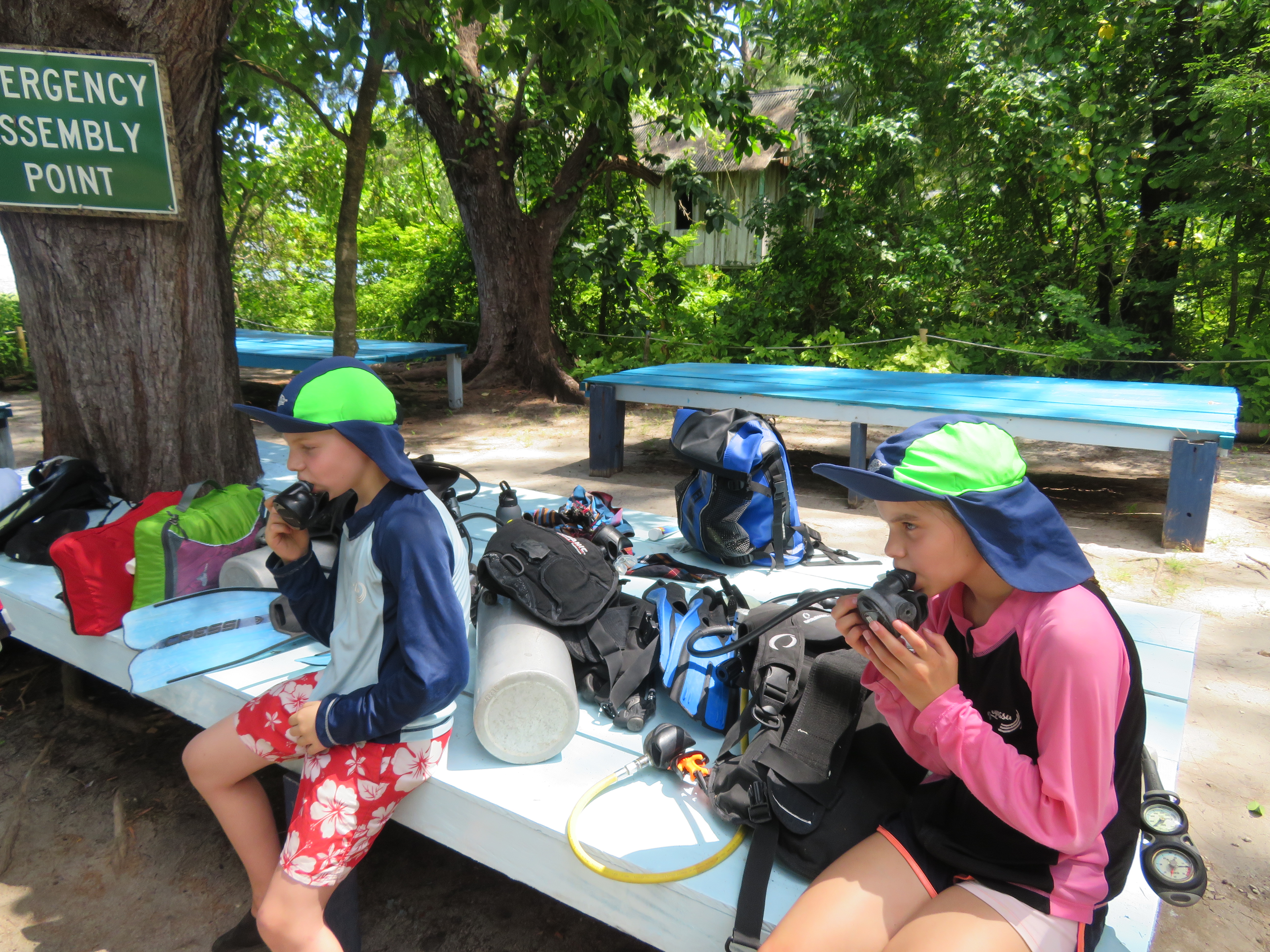
After a briefing on land and an opportunity to try out the equipment, we headed to the sea. The Beans put on their BCD in the water, tested their air and slowly swam out to the reef, with Alan and Nina (a dive master) helping them along. Once there and after a bit of effort sorting out their weights, they descended into the sea and immediately came face to face with one of the most beautiful reefs in the world on which swam hundreds of tropical fish. An anemonefish came out of its anemone to protect its young and swam right up to their masks! And at the end of the dive, they were surrounded by a large family of long trumpetfish! We dived alongside them and I could see, although they were clearly concentrating hard, just how much they were loving it. As soon as the dive was finished (which was far too soon in my opinion – I could have stayed down there all day), Bean8 asked when they could go down again! It was an amazing experience for us all.








We trekked the equipment back to shore along the pier and the Beans helped to take it all apart, clean it and put it away, before heading off for a hearty lunch, followed by a rest back at the hut. Later in the afternoon, we wandered back down to the dive centre to head out on a boat to the local Bajo village of Sampela. Traditionally a nomadic people, the Bajo live on stilted houses that float near to the shore of an island. They see themselves as very different to the Indonesians living on the nearby land and rarely mix with them (other than to sell them fish), instead adopting a seaborne lifestyle, catching fish in their little boats and living off the spoils of the ocean.



We were lucky enough to visit with an anthropologist who had previously lived with the Bajo people for ten years. He explained to us all about these fascinating people from their trust in sea spirits and associated ceremonies, to their (very sad) high rate of infant deaths due to the lack of medical care, to their wandering nomadic nature (they move between the different Bajo communities scattered across Indonesia, Malaysia and the Philippines – 30% of the Sampela population live outside of Sampela in other Bajo communities) to their belief that all food is for sharing. There is no sense of possession with food. If a fisherman nets a good haul, he is to share it with everyone before taking anything left over to sell in the local village.


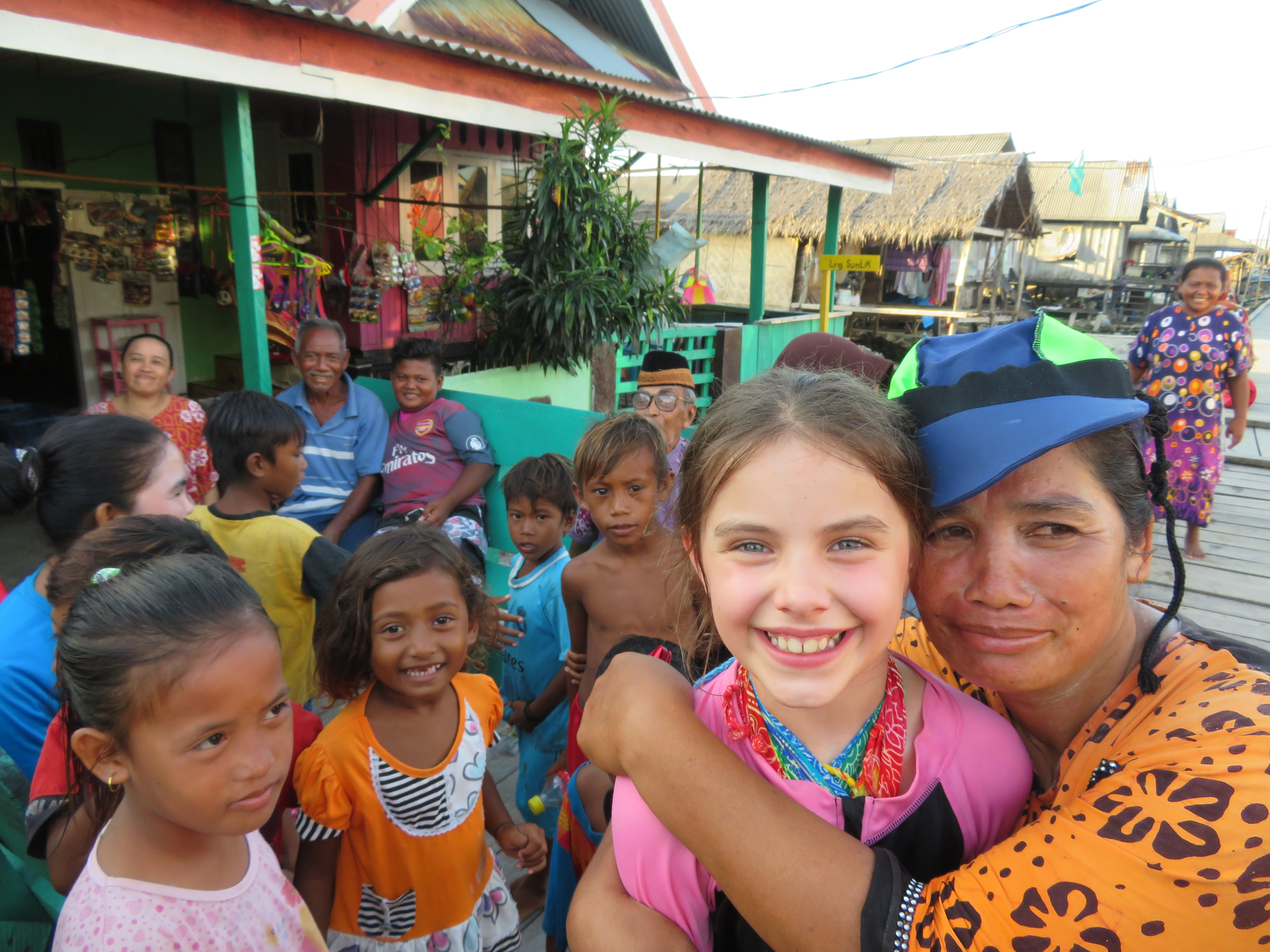



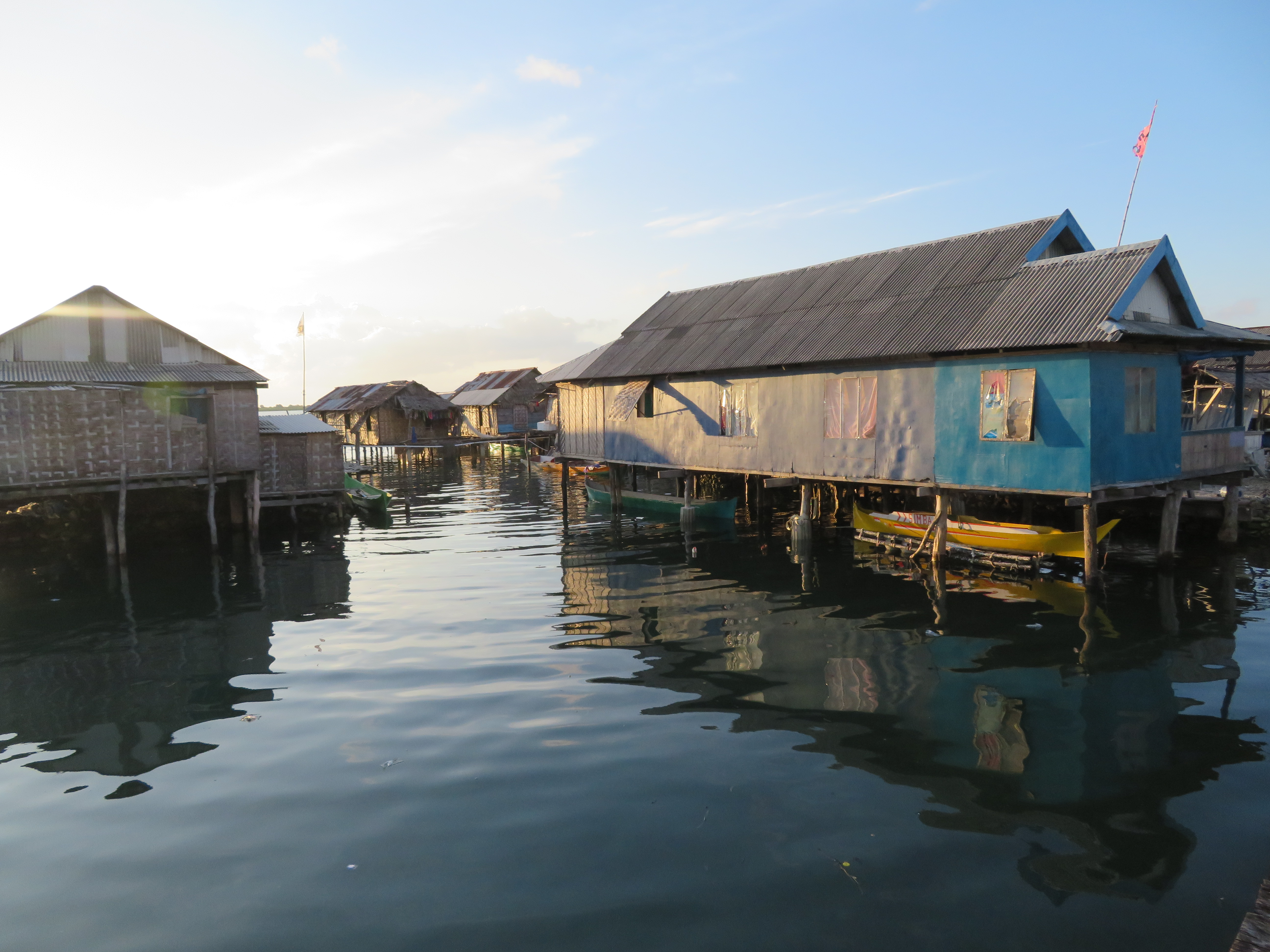

We had an opportunity to have a tour around the village to meet the people and see how they live. My overwhelming memory of the place is the beautiful happy children running after us and following our every move. I stopped to take some photos of them and then showed them the results, which they thought was hilarious! Thrilled by this, they crowded around me asking for more and more photos, all clamouring to see what they looked like afterwards and breaking down into fits of giggles on seeing their grinning faces on the camera!

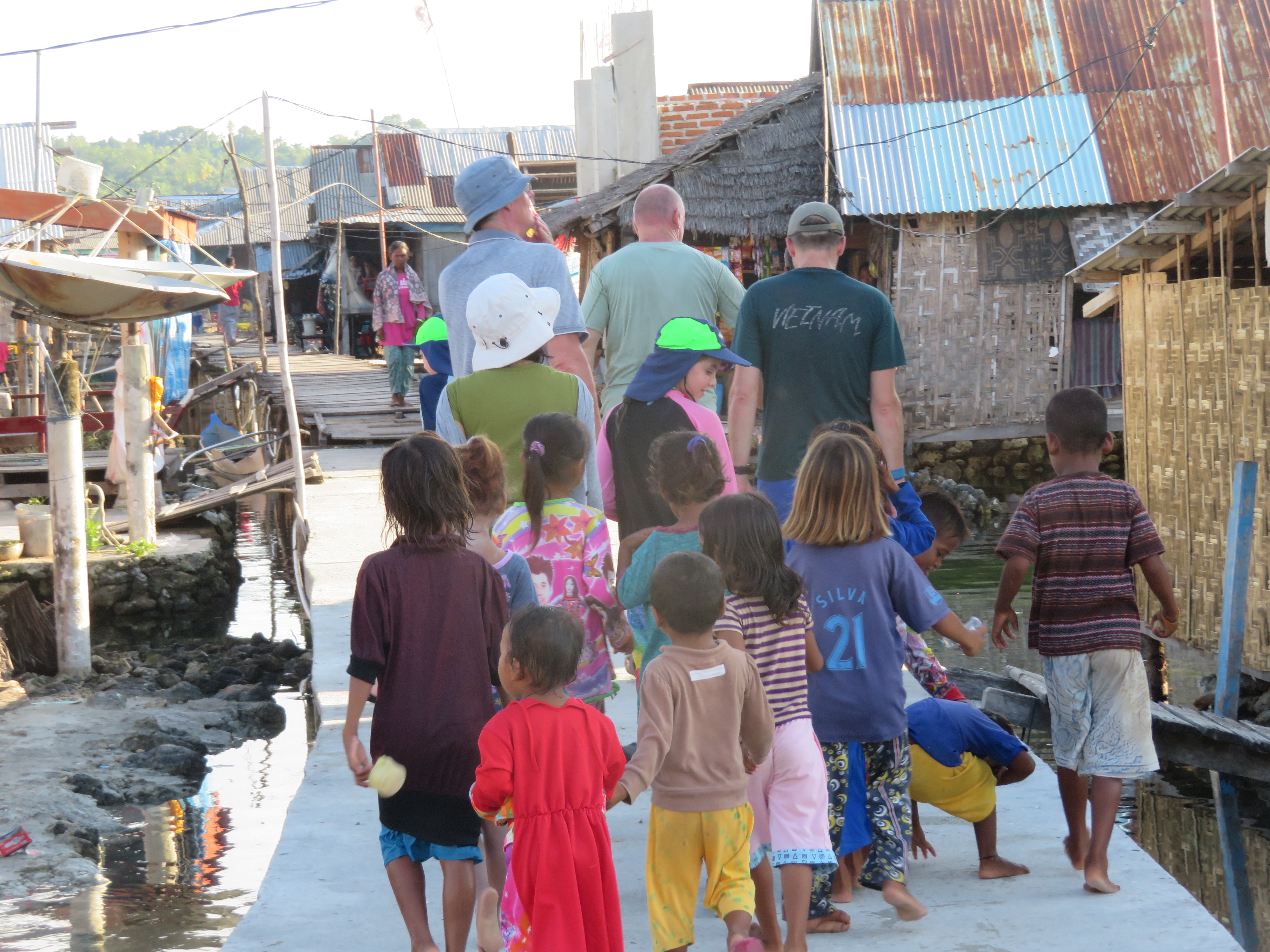
At one point, I spotted them playing a game of mini “football” with little cardboard figures of famous players used to kick a tiny metal ball into the toy goal. We went down to investigate and had a go at the miniature game with them whilst being swamped by children hanging on to our every limb. The Beans found the attention a little overwhelming at first (possibly also because it was so incredibly hot and they weren’t used to it), but eventually relaxed into it and by the end were running arund high fiving them all, each time eliciting great shouts of glee and laughter. Despite (or perhaps because of) having very little, these were some of the happiest children I’ve ever met. Quite an eyeopener for the Beans.

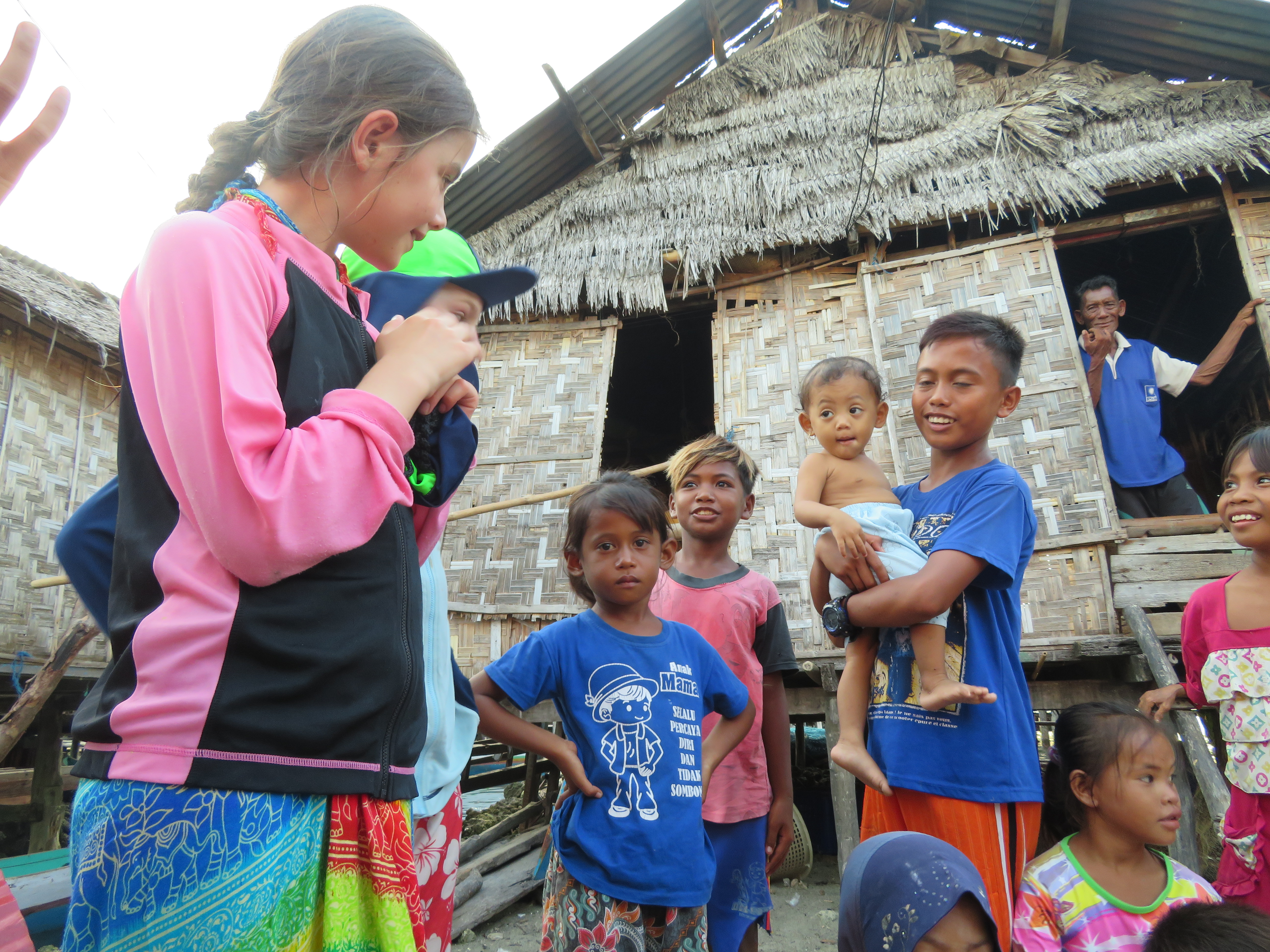


Day Two
Day two on Hoga unfortunately started with Bean8 being sick. Luckily it turned out to only be a one-day D&V virus, so it passed quickly although I felt desperately sorry for him as his fever continued to rise, not helped by the stiflingly hot external temperature. I took him down to the beach to cool down and we sat/swim around together in the shallows, chatting and admiring the view as tiny fish swam around and over us. Certainly my favourite place to nurse a sick child.
Bean9 on the other hand, had a wonderful day. She started the day learning how to wash clothes by hand at the well, pulling the water up herself and scrubbing the clothes alongside the local Indonesian ladies. She thoroughly enjoyed this process and came back with a huge beam on her face! Then, I took her snorkelling out from the jetty. We spent a long time swimming up and down the edge of this stunning reef spotting so many new species of coral and fish and waving to the divers! She was in a world of her own, completely absorbed in seeing first hand all she’d been learning about in her marine biology course. MrJ took her snorkelling again after lunch, where they managed to spot a sea snake, and then her Grandad took her on a walk to explore the island.
Day Three
Fortunately, Bean8 was better by the next day and VERY keen to get back out to the reef! First up though, was the opportunity to sit in on one of the post graduate lectures on algae. OK, so it doesn’t sound the most exciting topic, but the lecturer was excellent, and the Beans were completely transfixed by her description of the major genuses of algae. They scribbled away furiously in their notebooks, writing down the interesting facts and drawing the major types. She had lots of little tips of how to remember the genuses – for example the Tubinaria genus look like little Doritos attached together! The post grads were being encouraged to draw/write up their notes onto a diving slate to take down with them on the next dive in order to practise their identification skills. Clearly the Beans wanted to do the same thing, so we nipped down to the dive centre to borrow two slates, and they diligently wrote up their notes/drew the major types. Unfortunately, we couldn’t dive as the instructors were busy with the Open Water course for the under grads, so we took our slates out for another snorkel on the reef to see what we could spot. Regardless of how much they’ll remember about algae, they certainly learned how to concentrate carefully and take notes in a lecture, and it was great for the them to be surrounded by a group of young adults with such a passion for their topic.


After the snorkel, Bean9 and MrJ went for a walk with Grandad to the small village at the other end of the island, where Bean9 managed to find examples of five different algae genuses to show Beth, the lecturer. On a separate note though, she was utterly horrified by the vast quantity rubbish on the beach. This is something you’re constantly reminded of when travelling and it’s made us all determined to massively reduce our plastic usage. Sadly though, the vast majority of the rubbish on and around Hoga is from local products. Unfortunately, the Indonesians think nothing of using the ocean as a dustbin – Bean9 watched in horror as one lady just tipped all her rubbish out of the window straight into the sea. We all of us have a role to play in stopping our oceans becoming choked with our waste. Educating people in developing countries on how to manage their refuse sustainably is just a small part of the solution.


In the afternoon, it was time for another lecture on coral types. Despite still not being 100%, Bean8 refused to miss this opportunity. This time, the Beans even answered some questions on the major groupings of coral, and they were also aware of the different types of coral reef. The detail on the various genuses and how they differed was new to them though and they again scribbled away in their notebooks. The post grads were really kind with them, and one lady kindly lent them her excellent coral book for them to read whilst she was out on the dive. Bean9 spent ages using this book to help her write up her notes onto the dive slate. We then went out for the second snorkel of the day to spot what we’d just learned about. This time, we snorkelled out to the pinnacle where we’d been advised that a loggerhead turtle made its home. This was without doubt our best snorkel as we saw the beautiful turtle – Bean9 got really close to him as he swam up to the surface to take a breath. It was such a special experience.


Amazingly, we also saw a banded sea snake (the most venomous snake in the world) as well as a blue spotted ray, which I was particularly excited about as rays are Bean9’s favourite animal! In addition to these stunning creatures, the Beans managed to spot 9 of the 14 different types of coral from the lecture and was thrilled to show Beth her results!




Day Four
The final day on Hoga and a chance for another early morning dive. The Beans relaxed much more this time and although snorkelling is amazing, there’s something really very special about getting so up close and personal with the fish in their habitat rather than looking down on them. You enter their world and notice so much more. I watched on as Bean8 peered under a table coral to spot a bright yellow trumpetfish hiding underneath. Sadly, this was our last chance to get in the water, but we certainly made the most of it. As we were there for such a short time and the Beans were newbie divers, we couldn’t actually contribute to any of the ongoing conservation projects. But I have no doubt that we’ll be back when they’re old enough to do their Open Water and actually help with whatever project is going on at the time.

Hoga has been one of the most special parts of our trip. Oh, how I wish we’d planned more time here but with the flight changes, it squeezed our time available on this idyllic island. We all loved it and were very sad to leave. In addition to the spectacular environment, the people were so friendly. The kitchen staff spoiled the Beans rotten and on hearing that Bean8 was sick, brought out handmade chips for him. Given that there’s only ever tuna, rice and vegetables available on Hoga, this was a real treat. They also made him a cake and some doughnuts to build him back up – all the healthy treats! It was a wonder they managed to cook all these things in the small primitive kitchen available to them, but they were all delicious. They even came out to stand on the beach and wave us off in our little boat. So, after saying our farewells to all the students, teachers, diving and kitchen staff, we set off for the return journey. It was a short but very sweet visit and one we’ll never forget.







The Return Journey
We retraced our steps on the long journey out of Hoga, but this time the boat trip was in the daytime and therefore a lot less sick making! We all sheltered in the captain’s cabin which, whilst enclosed and thus with no risk of falling overboard, had no overpowering smell of a diesel engine!




We needed to overnight on Wanci Island, and I’d selected what looked like a good option and at £20/night for each room, it was a bit of a bargain, but my expectations were low. Unfortunately, it failed to live up even to these low expectations! It wasn’t good. But I do believe you have to experience the bad to appreciate the good! There was one moment over dinner (nasi goreng and some grilled octopus was all that was available from the menu), where we were sat on the floor (they didn’t appear to feel the need for tables and chairs in the restaurant!) with the wind blowing a gale whipping the plastic curtains they used to try and block out the horizontal rain about our heads, that I just had to smile. It was certainly a memorable experience. And where else can you find a goat sat outside your room refusing to budge or try and get into your room only to find that the door handle comes off in your hands!


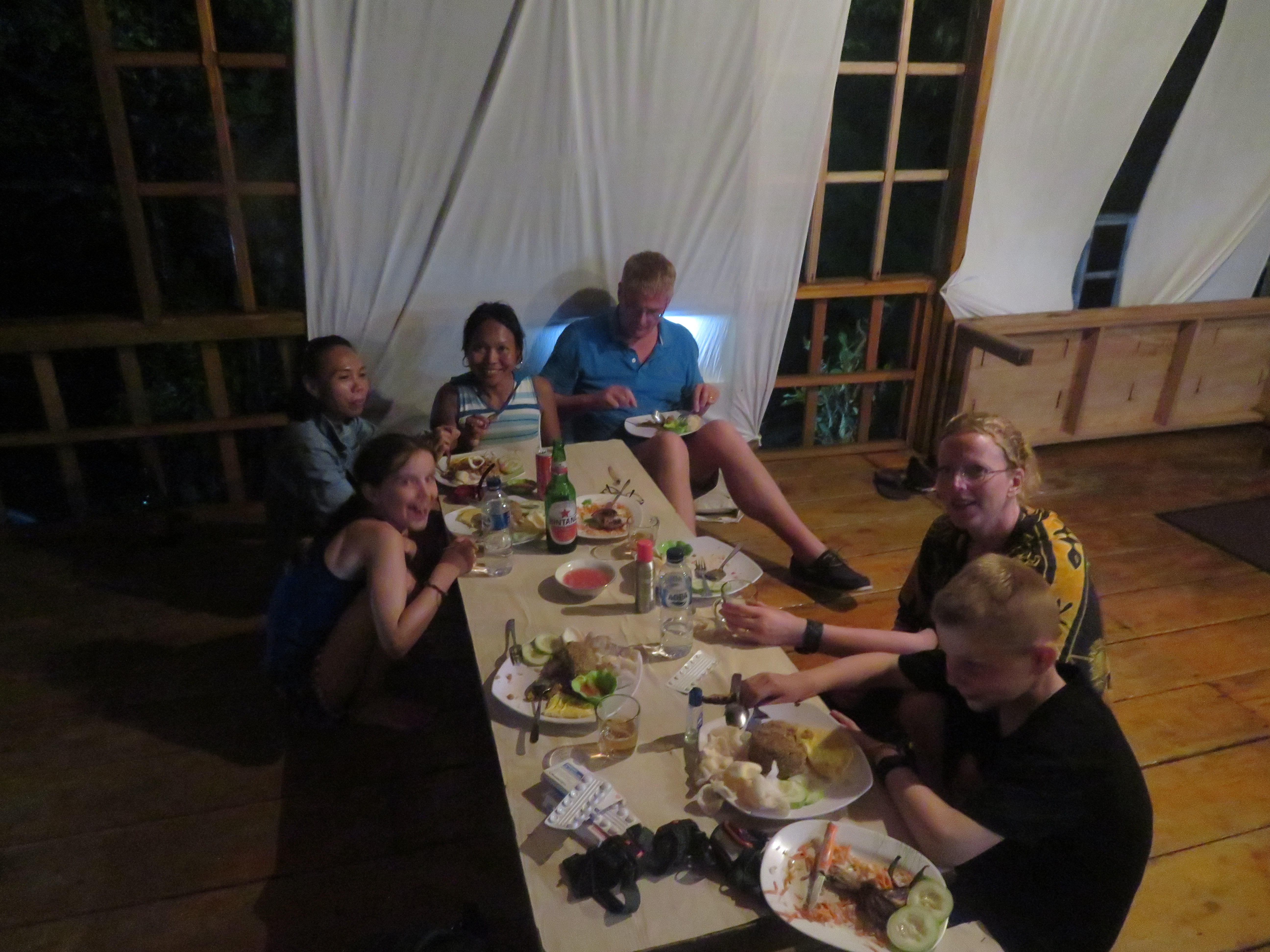
The next morning at 4am (we were up early to catch an early flight) I found myself moving between the rooms, wondering what the small black things were that kept sticking to my feet. In my dopey state, I just assumed they were some sort of seed from the trees. It was only when MrJ exclaimed at the huge amount of goat poo that I realised what treasures were attached to the soles of my feet. Ah, the joys of travel 😊

The next day we made it back to Makassar and into a much nicer hotel, with the luxuries of running water, a shower and a sink – bliss! We had plans to catch another early morning flight out to Maumere on Flores for the next part of our adventure. Unfortunately, in the middle of the night, Bean9 came down with the D&V virus. Given her state, there was no way we were going to be able to get her on a plane, so at 3:30am we busily figured out an alternative plan. The scarcity of flights to this island meant that we wouldn’t be able to get there until two days later which then put paid to our plans to climb Mt. Kelimutu and travel slowly across Flores discovering the local villages and tribes. But it clearly wasn’t meant to be. Instead, we spent a couple of days recovering in Makassar and headed straight to Labuan Bajo on the east coast of Flores to ensure we didn’t miss out on the opportunity to see the Komodo dragons. It meant a few more days of relaxing by the pool/at the beach, but to be honest after the hectic few months we’ve had, we welcomed the opportunity to completely relax. A mini chill out holiday within the trip. And now it’s on to the dragons – can’t wait!

All so very interesting. Thank you for sharing your diary with us.
LikeLike
Just re read your blog Debbie.
It’s so interesting!
LikeLike
Sweet memories. Indeed the children of Sampela are amongst the happiest you’ll see. Hopefully, though, the school appeared to you in better operation, compared to August 2018.
LikeLike